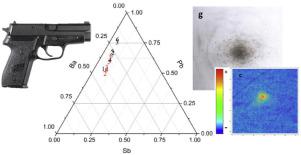Talanta Open ( IF 4.1 ) Pub Date : 2020-10-29 , DOI: 10.1016/j.talo.2020.100017 Silvia Fabbris , Antonella Profumo , Gianluca Alberini , Sara Bonomi , Chiara Milanese , Matteo Donghi , Alberto Amadasi , Maddalena Patrini , Lucia Cucca , Daniele Merli

|
This study relies on the ability of six different fabrics to retain gunshot residues on their surfaces, and their capability to let them pass through. The fabrics were cotton, linen, elastane, polyester, silk and viscose, each of them placed above a filter paper sheet. This last was used to retain residues passing through fabric. Microscopic structures of the chosen textiles were characterized by optical microscopy, and their surface morphology was characterized by stylus profilometry. A semi-automatic Sig Sauer P228 pistol, calibre 9 × 21 mm IMI, was exploited and two shooting distances were considered, 10 cm and 40 cm. Preliminary, inorganic residue (IGSR) deposition patterns were visualized by X-ray fluorescence spectroscopy. Scanning electron microscopy was also used to describe morphology and composition of IGSR generated by discharging the selected gun. Concentration of IGSR on targets was then quantitatively determined by inductively coupled plasma optical emission spectrometry, while nitrites and nitrates, originated by nitrocellulose content of smokeless powders, were identified by ion chromatography. As expected, the amount of metallic residues, nitrites and nitrates decreases inversely with the shooting distance. In addition, considering the same distance, concentration of these elements changes significantly depending on the analyzed cloth. Therefore, when evaluating shooting distance in a forensic case, the habit to use a cotton textile to construct a calibration curve, despite of the actual nature of the target, could not be quantitatively accurate. It was evidenced that a significant amount of GSR passed through target fabrics, making their identification possible even on underneath tissues.
中文翻译:

枪支残留物(GSR)与具有不同结构特征的天然和合成纺织品的相互作用
这项研究依赖于六种不同织物在其表面上保留枪击残留物的能力,以及使其通过的能力。织物是棉,亚麻,弹性纤维,聚酯,丝绸和粘胶纤维,它们各自放在滤纸上面。该最后一个用于保留残留物穿过织物。所选纺织品的微观结构通过光学显微镜表征,其表面形态通过测针轮廓仪表征。使用口径9×21 mm IMI的半自动Sig Sauer P228手枪,并考虑了两个拍摄距离,分别为10 cm和40 cm。初步的无机残留物(IGSR)沉积模式通过X射线荧光光谱法可视化。扫描电子显微镜还用于描述通过排出选定枪支而产生的IGSR的形态和组成。然后,通过电感耦合等离子体光发射光谱法定量测定靶标上的IGSR浓度,同时通过离子色谱法鉴定无烟粉末中硝化纤维素含量引起的亚硝酸盐和硝酸盐。正如预期的那样,金属残留物,亚硝酸盐和硝酸盐的量与射击距离成反比地减少。此外,考虑到相同的距离,这些元素的浓度会根据所分析的布料而显着变化。因此,在法医情况下评估射击距离时,尽管目标物的实际性质,使用棉纺织物绘制校准曲线的习惯在定量上也不是准确的。











































 京公网安备 11010802027423号
京公网安备 11010802027423号